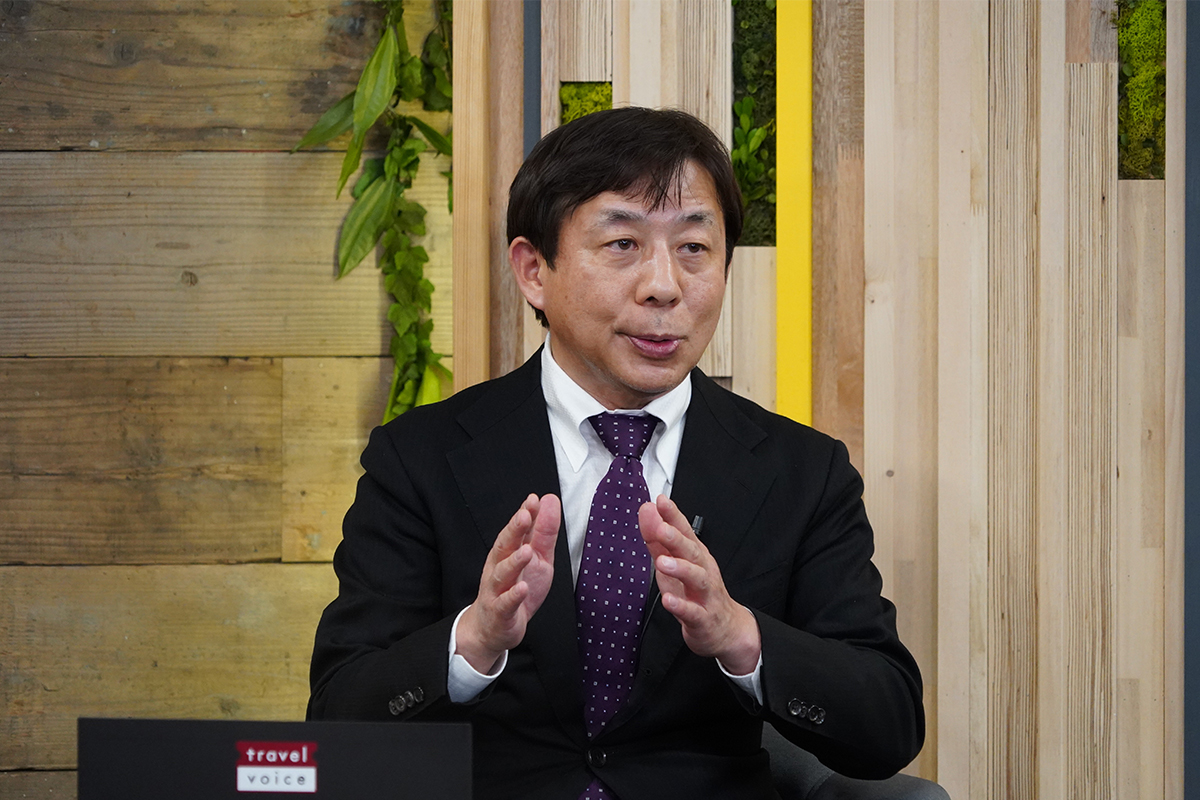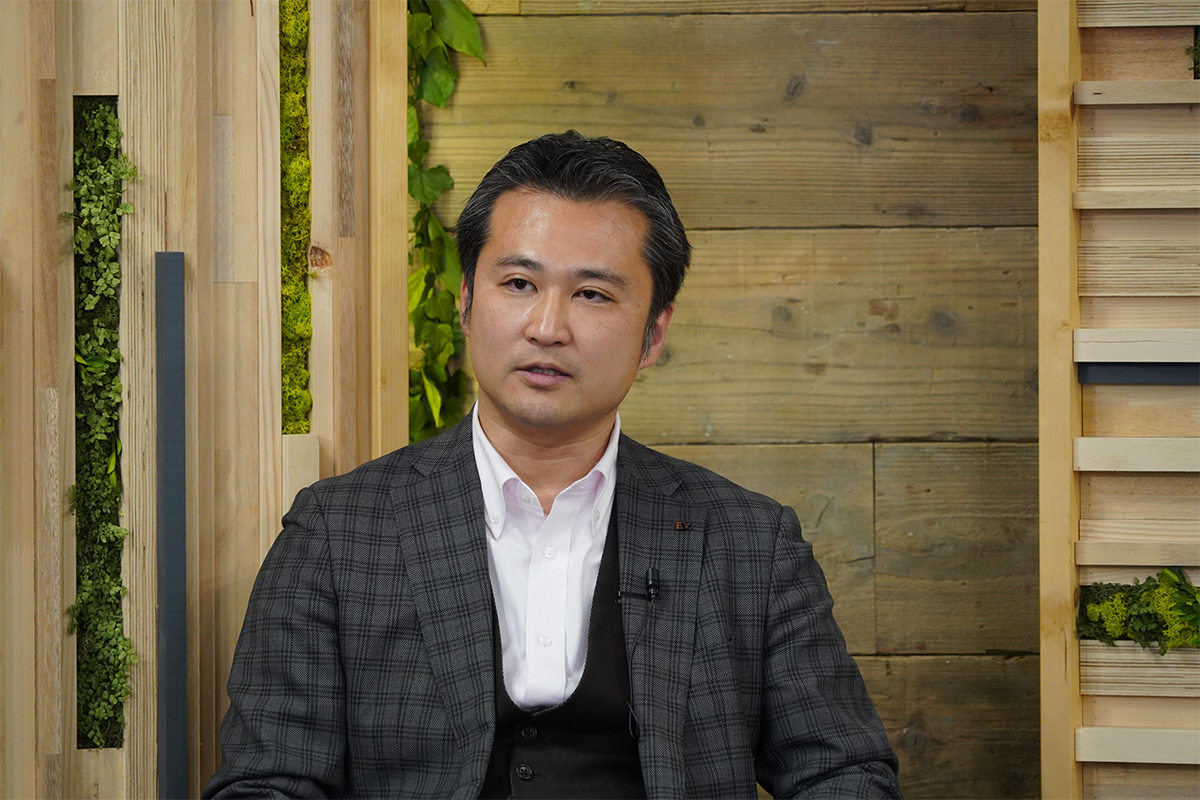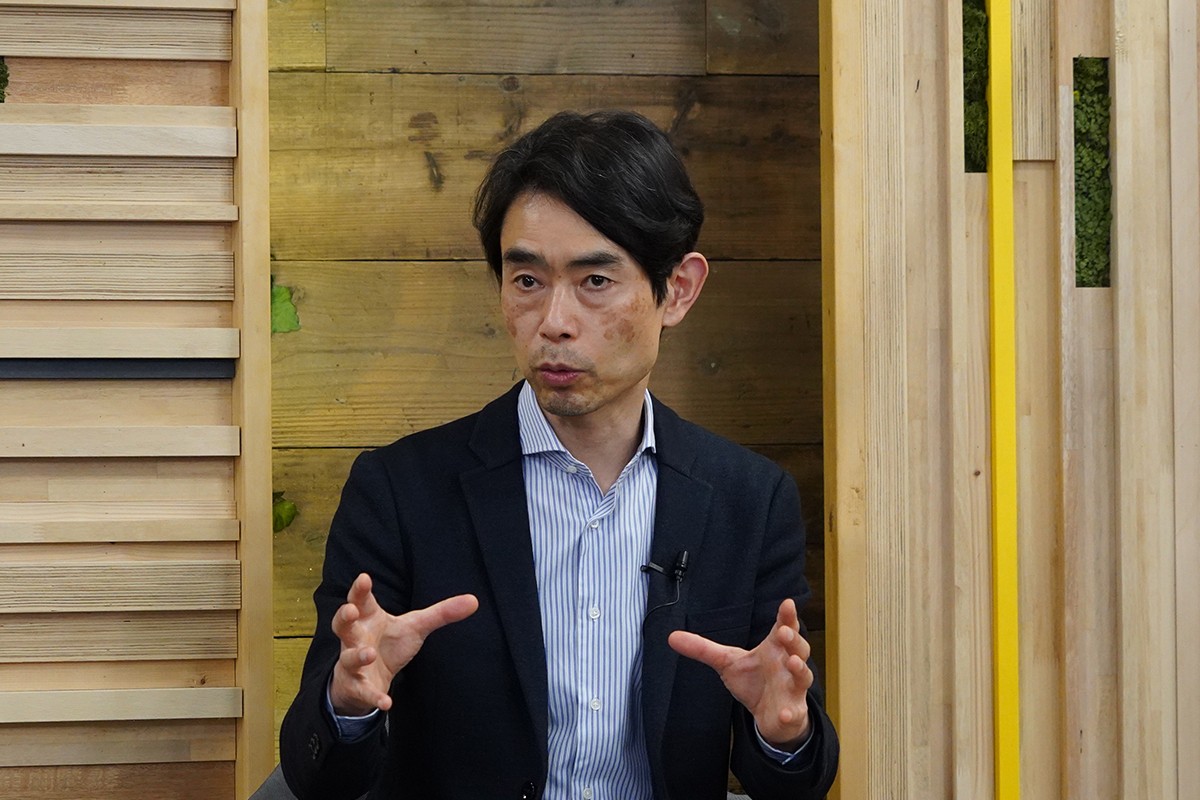
Section 1
Keynote #1: Tourism trends in the recovery phase: the potential for cross-industry cooperation to support digital transformation (DX) in tourism
The COVID-19 pandemic materially changed the direction of tourism development. Koji Tsurumoto, a 20-year veteran of the industry, sees tourism DX gaining momentum in the future.

Koji Tsurumoto, CEO of Travel Voice Japan Ltd.
“Workation” is a travel choice which includes vacation while working remotely at destinations and resorts. Even the word workation blurs the boundaries between travel and daily life. Tsurumoto pointed out that one recent phenomenon in the tourism industry has been a shift in the dividing line between our personal life (including work styles) and travel: where you work becomes meaningless the more remote work is normalized.
Remote work was common in the United States and Europe even before the COVID-19 pandemic, while allowed by only a minority of companies in Japan. However, the pandemic has had a drastic impact on work styles. If remote work becomes part of our daily routine, we will see changes to our traditional travel pattern of working in a central location on weekdays and visiting destinations and resorts for vacation.
“Until 2019, it made sense to take paid leave for personal travel. However, as a result of the increase in remote work and the diminishing importance of our work location, we are now in an era which allows us to travel without taking paid leave. Taken to the extreme, we might begin the week in a new location, work there during the day, enjoy the nightlife after work, and add some additional local travel on the weekend. If so, our definition of travel and tourism will also change.” Phocuswright, a leading authority in travel, tourism and hospitality market research from the USA, forecasts that Japan’s travel market will not recover to pre-COVID-19 levels until 2024, nor will the nature of the market return in its previous form.
(Source: "Two key developments in Japan's travel market", Phocuswright, June 2021,https://www.phocuswright.com/Travel-Research/Research-Updates/2021/two-key-developments-in-Japans-travel-market(Access date : 8 February 2021)
In addition, the spread of COVID-19 has changed the range of products available and how we spend time at a destination. For example, restaurant menus and visitor information signs ask visitors to scan QR codes on smart phones. This reduces “contact” (i.e., human interaction), which previously would have been a highlight of travel, while contact-free interaction for products and services has become an added-valued service. Tsurumoto indicated that these trends and the evolution of digital technology will continue and increase the momentum of tourism DX.
Tourism DX covers a wide range of fields. Tsurumoto listed five categories which have seen significant growth in recent years: 1) Tabinaka (support while travelling), which includes travel devices and electronic payments; 2) Ground transport, including ride-hailing services and car sharing; 3) Hospitality, including vacation rentals and IT-enabled hotels; 4) Aviation, using airport technology, 5) Smart tourism, with online travel and content for visitors , and online reservations and e-marketplaces. In particular, we are seeing the rise of new services from start-ups both in Hospitality where digitalization was slow previously, and in the Smart category (simplified services by digitalization).
In his keynote, Tsurumoto introduced Refundit from Israel and Youtip from the United States as case studies for innovation in tourism DX.
Refundit is a service that makes it easier for international travellers to claim a refund of sales taxes such as VAT, GST, etc. Travellers use the app to upload a photo of their receipts and apply for the exemption, receiving a refund to their credit card 15 minutes later. Traditional tax exemption procedures are complicated and require tourists to spend a significant amount of time on them while travelling. Refundit claims to simplify these procedures. This is also beneficial for the relevant tax authorities: the app enables a shift from paperwork to digital data exchange, which can dramatically shorten processing times.
Youtip offers a different example: it is a digital solution for tipping. Venues collecting tips, such as restaurants and hotels, need only create a Youtip account to receive payment (a tip) by QR code from customers.
Youtip has become popular because, while the spread of cashless payment has encouraged tourists to carry little-to-no cash, employees in the service industry have traditionally been paid in cash. Tourists can now easily leave a tip via Youtip without the need for cash.
Tsurumoto considers:
“Youtip not only simplifies tipping but also helps to maintain employee motivation (from earning tips) and to streamlining payment of tips (payment management). It’s an innovative service for everyone.”
Tsurumoto concluded with the following remark:
“Tourism DX is still at an early stage but the evolution of fintech services like Refundit and Youtip will play a role in accelerating tourism DX. We expect these services to proliferate in the decade leading to 2031.”

Section 2
Keynote #2 The future of tourism by 2031: Tourism is the foundation of social and economic activity
What do we need to bear in mind if we are to keep pace with rapid changes in tourism and properly understand tourism megatrends? Observations from Tomotaka Hirabayshi of EY Strategy and Consulting

Tomotaka Hirabayashi, Director, EY Strategy and Consulting Co., Ltd.
Domestic tourism spending in Japan has plunged due to the pandemic and the spread of COVID-19 infections. According to surveys by the Japan Tourism Agency (“Travel and Tourism Consumption Trend Survey” and “Consumption Trend Survey for Foreigners Visiting Japan”), Japan’s domestic tourism spending plummeted from 26.8 trillion yen in 2019 to 10.7 trillion yen in 2020. Hirabayashi commented, “The tourism industry has to respond urgently to digitalization, sustainability, and over-tourism.” He warned that in the new normal era, destinations and tourists that are resistant to changes in the business model may be excluded from the market.
Hirabayashi highlighted three paradigm shifts in the new normal era:
- Conceptual changes in tourism
- Changes to traveller expectations of value
- Changes in the balance of power between tourists and destinations
Hirabayashi identified the increase in digitally-enabled virtual tourism as one example of conceptual changes in tourism because the previous predominant business model - based on the premise of mobility (travel to the destination) - was devasted by the pandemic. When examining changes to traveller expectations of value, Hirabayashi explained how the focus of travellers is shifting from the low price and convenience of a destination to whether it offers a safe and secure environment, even if it comes at additional cost. Regarding changes in the balance of power between tourists and destinations, he expects that destinations, which prioritized attracting tourists to generate spending in local communities and were in a weaker position relative to those visitors, will be able to reject tourists if they do not respect local measures for infection prevention during the pandemic. As a result, destinations would be in a stronger position than their visitors.
So which kind of megatrends will emerge from these changes? Hirabayashi explained that, “the important point is that relationships between tourists, tourism businesses and destinations will be closer than ever before.”
For example, the relation between tourists and tourism businesses can be expected to shift from “being distant” to “being close.” In the “distant” paradigm, services are just temporarily and unilaterally provided by tourism businesses. In the “close” paradigm, tourists and tourism businesses build sustainable and two-way relationships whereby tourists provide tourism businesses with labor, know-how, etc in exchange for services received from these businesses. For example, a tourist staying at a hotel which is struggling with digitalization can provide IT support or a tourist staying in an agricultural area can help a farmer to harvest crops. Hirabayashi predicts a move in this direction.
Similarly, Hirabayashi expects relationships between tourism businesses to shift towards cooperation between companies in the same communities and industries, compared with the existing model where they consider other companies as rivals and try to maximize their own profits. The driver for this change will be a requirement for tourism businesses to embrace “regional optimization” in order to meet increasingly diverse and distinct tourist needs.
Hirabayashi said:
“In particular, destinations will significantly change their focus. Previously, destinations put so much emphasis on the short-term value created by tourists that they alienated local residents. This is one of the reasons for over-tourism. A balance will need to be struck between destinations and tourists if sustainable tourism is to be achieved. I predict that destinations which don’t prioritize sustainability will not survive because few tourists will travel there.”
He added, “Tourism itself has the potential to become the foundation for all social and economic activities.”
Tourism has connections to a wide range of industries such as transportation, accommodation, tourist facilities, restaurants, and the conventions/MICE sector. All other industries, including agriculture, manufacturing and financial services, will be present in the tourism industry in the future. In other words, the digitalization of different types of tourism-related transactions will feed into huge databases for industries and consumption. Hirabayashi predicts that if the use of such databases results in the creation of new industries and services, tourism will be a springboard for invigorating all of society.
Hirabayshi closed his presentation with the following summary:
“The essence of tourism is to promote mutual understanding of “differences,” whether it be culture, history, or ideology, between tourists and residents, i.e., people who visit and people who live in these destinations. I believe that Japan can enhance its presence in the international community and contribute to social and economic activity by encouraging people to grow through tourism.”

Section 3
Panel discussion #1: Real world and metaverse travel can co-exist
In the panel discussion later in the webinar, the panellists discussed how the COVID-19 pandemic affected society as well as how mobility, the metaverse and other digital technology will transform tourism.
![(Photo)from right: Koji Tsurumoto, CEO of Travel Voice Japan Ltd. ; Ikuyo Namigata, Head of Planning and Research and an executive officer in JTB Tourism Research & Consulting Co.; Yoshiro Tsuruhara, CEO, Technology Journalist/Editor, AutoInsight, Inc. Moderator [left] Tomotaka Hirabayashi, Director, EY Strategy and Consulting Co., Ltd.](https://assets.ey.com/content/dam/ey-sites/ey-com/ja_jp/topics/consulting/the-future-of-tourism-with-corona-and-post-corona/ey-the-future-of-tourism-with-corona-and-post-corona-seminar.jpg)
(Photo)from right: Koji Tsurumoto, CEO of Travel Voice Japan Ltd. ; Ikuyo Namigata, Head of Planning and Research and an executive officer in JTB Tourism Research & Consulting Co.; Yoshiro Tsuruhara, CEO, Technology Journalist/Editor, AutoInsight, Inc.
Moderator [left]
Tomotaka Hirabayashi, Director, EY Strategy and Consulting Co., Ltd.
Japan’s first confirmed case of COVID-19 infection was reported in January 2020. At the time, few people predicted that the pandemic would last longer than two years. How has Japanese society changed because of the prolonged pandemic? Ikuyo Namigata commented that “Society has been impacted enormously. One clear example is how public transport agencies have been forced to modify their timetables.”
JTB Tourism Research & Consulting Co., where Namigata serves as the Head of Planning and Research, has conducted more than 10 awareness surveys in the 2 years since February 2020. The surveys revealed that “younger generations have changed how they view digital technology.” Immediately after the government declared the first state of emergency and issued a stay-at-home request, most young people voiced “a desire to return to face-to-face encounters in the real world.” However, in later surveys, they came to think that “things that can be streamlined through digitalization should be digitalized, but things that can only be felt physically should be experienced in person in the real world.”
Tsurumoto also noted that “digitalization has exerted even greater influence on tourism due to the length of the COVID-19 pandemic.”
Travel used to involve people changing their physical location. However, advances in digital technology and a lengthy pandemic have changed people’s behaviour. For example, in the field of education, students could not meet each other on international exchanges due to travel restrictions, although connecting online was easy. Tsurumoto expects that “the time will come when we interact online for what can be done virtually but agree to continue discussions in person – to see each other face-to-face – instead of thinking ‘no need to get together in person since we interact online.’”
Digital technology also has major influence on mobility. Being asked about the influence of Mobility as a Service (MaaS) and autonomous vehicles on future tourism, Tsuruhara described it as “a kind of revolution if emerging autonomous vehicles broaden our horizons and take us to places unreachable by public transport.”
“For instance, if elderly people can use a robot for walking assistance or a wheelchair with an autonomous driving function to explore a destination, they will have more power to choose what to do. Digital technology has enormous potential for travel.”
The metaverse is another digital technology attracting attention. In the metaverse, a user can freely explore a virtual world through their digital representative (avatar). What will be its role in tourism?
Tsurumoto explained how “some people say that if they can travel in a virtual world, then they will not go to the physical location. But the best part of travel is to experience places with all our senses, such as its temperature or smell, which can only be enjoyed on site. The metaverse experience and physical travel are very different.” Hirabayashi, the moderator, also commented, “As virtual and real-world travel play different roles, it will be easy to distinguish between them.”

Section 4
Panel discussion #2: Sustainable initiatives involving tourists will be key
In the period leading to 2031, “information disclosure” and “co-existence with local communities” will become important for inbound tourism. What will be needed to achieve sustainable tourism without exhausting one-of-a-kind tourism destinations?

Ikuyo Namigata, Head of Planning and Research and an executive officer in JTB Tourism Research & Consulting Co.
In the post-pandemic era, demand for inbound tourism is also expected to change. Namigata revealed the survey results for tourists from the UK, Australia and China. While Chinese tourists focus on whether a destination is taking precautionary measures, tourists from Britain and Australia require a destination “to provide sufficient safety information,” and are likely to seek a relaxing time in nature while relying on their own judgement drawn from the safety information.
Tsurumoto also pointed out the importance of information disclosure as people are increasingly interested in balancing decarbonization and travel.
“People in other countries are taking a harder look at decarbonization efforts than Japanese people might imagine. For example, when selecting a hotel, one deciding factor is whether it is environmentally friendly and sustainable. As a result, hotels and the hospitality sector in Japan need to highlight their green credentials; in the meantime, they will need to reflect tourist needs in their operations by considering environmental initiatives as opportunities to differentiate their business.”
However, cost is a cause for concern. Affordability is important to tourists when choosing a destination, but sustainability initiatives are costly for hotel and hospitality operators. On this point, Tsurumoto explained that “if the facility has a story, then tourists will pay a higher price. Hotels need to clearly explain their efforts – that is, their story – for why the price has increased. If tourists are satisfied with that story, they will pay the higher price and feel like they are contributing financially to sustainability initiatives. Efforts like this become added value for tourists.”
From a sustainability point of view, tourists are taking an interest in the means of transportation. Responding to measures for infection prevention, they are drawn to visiting nearby locations (referred to as “micro-tourism”) while avoiding “closed spaces, crowded places and close-contact settings” also known as “the 3Cs” by Japan’s Ministry of Health. Tsuruhara identified an emerging trend: “The need for personal mobility - such as a small electric vehicle - is growing. And personal mobility is gaining attention as a solution for the various issues faced by destinations.”

Yoshiro Tsuruhara, CEO, Technology Journalist/Editor, AutoInsight, Inc.
Traffic jams caused by tourists were one of the issues previously faced by destinations. Many tourists poured into destinations in their own cars causing congestion on residential roads and disrupting everyday life for residents. Tsuruhara explained that “if personal mobility or autonomous vehicles can operate in narrow streets at a destination, it will help ease overtourism.”
For example, if tourists use park-and-ride schemes to switch to more environmentally friendly forms of personal mobility, we can protect the environment and natural landscape of the destination, better known as “regional resource content.” In fact, once a natural landscape is destroyed, destinations are never again able to use it to attract tourists. Tsuruhara, Namigata and Tsurumoto all agreed that a symbiotic relationship with nature is at the heart of sustainable tourism.
Bringing the discussion to a close, when asked about the ideal form of tourism in the future, Namigata remarked that “Future tourism will bridge the differences between those who travel and those who don’t.”
She added that “In the future, experiences gained in the metaverse will be considered ’travel’ and incorporated in the market. I view travel as something that will enhance human excellence as we interact with the unknown and, based on that experience, reflect on those interactions in our inner world. This is why I don’t want travel, virtual or real, to be treated as a consumer good. I want it to be something that inspires our imagination.”
Summary
A recurring theme of the webinar is the need to redefine tourism. A “workation” lifestyle, popularized during the COVID-19 pandemic, has made tourism an everyday event. In addition, emerging digital technologies such as the metaverse have the potential to undermine the concept of mobility in travel. We need to explore a multi-layered concept of tourism which embraces travel in the metaverse and the real world.


